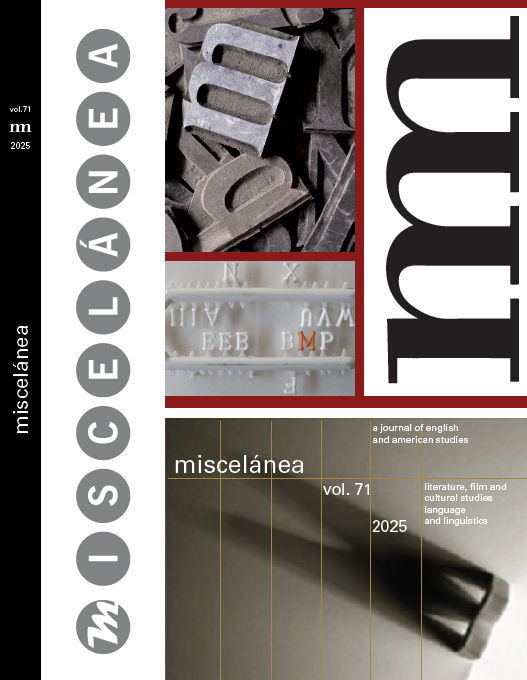Compositional Argument Selection in N+V Qualia Pairs within the Discourse of Cooking: A Corpus-based Study
DOI:
https://doi.org/10.26754/ojs_misc/mj.202510185Keywords:
argument selection, compositional analysis, syntactic alternations, discourse of cooking, qualia pairsAbstract
This paper aims to analyse the compositional argument selection process represented by different syntactic alternations within the specialised domain of cooking, thus contributing to the characterisation of this specialised discourse. The syntactic alternations studied include canonical actives, passives, causative/inchoative alternations, middles and Instrument-subject alternations. These constructions allow the incorporation of cooking verbs (Levin 1993) and denote divergent argument structure realisations. As indicated here through compositional analysis, the constructions contain distinctive N+V qualia pairs. As in Pustejovsky (1991, 1995), this paper follows a lexico-semantic approach and applies a corpus-based methodology to examine and compare over 8,300 contextualised examples from two corpora (a specialised corpus on cooking and a general corpus) using the Sketch Engine corpus tool. The results show that the syntactic alternations examined follow related but distinctive underlying patterns in semantic composition, and thus are construed with N+V qualia pairs that characterise the specialised discourse of cooking.
Display downloads
References
BATOR, Magdalena. 2014. Culinary Verbs in Middle English. Peter Lang. <https://doi.org/10.3726/978-3-653-04576-5>. DOI: https://doi.org/10.3726/978-3-653-04576-5
CASADEMONT, Anna Joan. 2014. “On the Elements Activating the Transmission of Specialised Knowledge in Verbs”. Terminology 20 (1): 92-116. <https://doi.org/10.1075/term.20.1.05joa>. DOI: https://doi.org/10.1075/term.20.1.05joa
DURÁN-MUÑOZ, Isabel and Marie-Claude L’HOMME. 2020. “Diving into Adventure Tourism from a Lexico-semantic Approach: An Analysis of English Motion Verbs”. Terminology 26 (1): 33-59. <https://doi.org/10.1075/term.00041.dur>. DOI: https://doi.org/10.1075/term.00041.dur
GIVÓN, Talmy. 1993. English Grammar. A Function-based Introduction (Vol. II). John Benjamins. <https://doi.org/10.1075/z.engram2>. DOI: https://doi.org/10.1075/z.engram2
HALE, Ken and Samuel Jay KEYSER. 2002. Prolegomenon to a Theory of Argument Structure. The MIT Press. <https://doi.org/10.7551/mitpress/5634.001.0001>. DOI: https://doi.org/10.7551/mitpress/5634.001.0001
KILGARRIFF, Adam, Pavel RYCHLÝ, Pavel SMRZ and David TUGWELL. 2004. “The Sketch Engine”. In Williams, Geoffrey and Sandra Vessier (eds.) Proceedings of the Eleventh EURALEX International Congress. Lorient, France: 105-116.
LANGACKER, Ronald. 2013. “Settings, Participants, and Grammatical Relations”. In Tsohatzidis, Savas (ed.) Meanings and Prototypes: Studies in Linguistic Categorization. Routledge: 213-238.
LEHRER, Adrienne. 1969. “Semantic Cuisine”. Journal of Linguistics 5: 39-55. <https://doi.org/10.1017/S0022226700002048>. DOI: https://doi.org/10.1017/S0022226700002048
LEHRER, Adrienne. 1972. “Cooking Vocabularies and the Culinary Triangle of Lévi-Strauss”. Anthropological Linguistics 14 (5): 155-171.
LÉVI-STRAUSS, Claude. 1966. The Culinary Triangle. Partisan Review.
LEVIN, Beth. 1993. English Verb Classes and Alternations: A Preliminary Investigation. The University of Chicago Press.
NEWMAN, Aryeh. 1975. “A Semantic Analysis of English and Hebrew Cooking Terms”. Lingua 37: 53-79. <https://doi.org/10.1016/0024-3841(75)90004-2>. DOI: https://doi.org/10.1016/0024-3841(75)90004-2
PALMA GUTIÉRREZ, Macarena. 2022. A Family-resemblance Analysis of the Middle Construction: A Functional-cognitive Approach. Phd Dissertation. Universidad de Córdoba.
PALMA GUTIÉRREZ, Macarena. 2024. “Profiling and Defocusing Phenomena in the Discourse of Fe/male Novelists: A Corpus Based Approach”. In Jiménez-Navarro, Eva Lucía and Leonor Martínez Serrano (eds.) Where Gender and Corpora Meet: New Insights into Discourse Analysis. Peter Lang: 135-156.
PUSTEJOVSKY, James. 1991. “The Generative Lexicon”. Computational Linguistics 17 (4): 409-441.
PUSTEJOVSKY, James. 1995. The Generative Lexicon. The MIT Press. <https://doi.org/10.7551/mitpress/3225.001.0001>. DOI: https://doi.org/10.7551/mitpress/3225.001.0001
PUSTEJOVSKY, James. 2001. “Type Construction and the Logic of Concepts”. In Bouillon, Pierrette and Federica Busa (eds.) The Syntax of Word Meaning. Cambridge U.P.: 1-37.
PUSTEJOVSKY, James. 2006. “Type Theory and Lexical Decomposition”. Journal of Cognitive Science 6: 39-76.
PUSTEJOVSKY, James and Elisabetta JEZEK. 2016. A Guide to Generative Lexicon Theory. Oxford U.P.
RYCHLÝ, Pavel. 2008. “A Lexicographer-friendly Association Score”. In Sojka, Petr and Aleš Horák (eds.) Proceedings of Recent Advances in Slavonic Natural Language Processing. Masaryk University: 6-9.
SAGER, Juan. 1990. A Practical Course in Terminology Processing. John Benjamins. <https://doi.org/10.1075/z.44>. DOI: https://doi.org/10.1075/z.44
SERRANO-LOSADA, Mario. 2015. “Multimodal Metaphorical and Metonymic Renderings of Pain in Advertising: A Case Study”. Revista Electrónica de Lingüística Aplicada (RAEL) 1 (14): 35-50.
SKETCH ENGINE. 2023. Lexical Computing Limited. <https://www.sketchengine.eu/>. Accessed July 09, 2024.
STOCKWELL, Peter. 2002. Cognitive Poetics: An Introduction. Routledge.
YOSHIMURA, Kimihiro. 1998. “The Encyclopedic Structure of Nominals and Middle Expressions in English”. Kobe Papers in Linguistics 1: 112-140.
Published
Issue
Section
License
Copyright (c) 2025 Macarena Palma Gutiérrez

This work is licensed under a Creative Commons Attribution-NonCommercial 4.0 International License.
How to Cite
Accepted 2024-09-02
Published 2025-06-16


